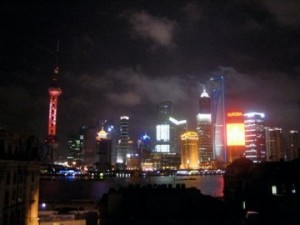Shanghai State of Mind (上海) Posted by Stephen on Aug 15, 2011 in Culture
Imagine a city with enough fluorescent lighting and big screen LED displays to put Vegas and Tokyo both to shame. Add some classical chinese hutongs (胡同) and buildings, mix in some 19th century, stately British architecture (along the bund) and surround all that by hulking skyscrapers, many of which have shot up within the last two decades. Throw in some Chinese nightmarkets (夜市), KTV (karaoke) spots, nightclubs and tea houses, but make sure there’s room for Starbucks and Mcdonalds on every block. Put all these images together and what do you have? The ever-evolving, and always bustling city of Shanghai, China (上海).
To understand Shanghai’s transition from a small, agrarian/fishing society into the international metropolis affectionately called the “Pearl of the Orient” of today, a brief history or 历史 (lì shǐ) is required:
Prior to western invasion/interaction (whatever you want to call it), Shanghai and the surrounding region, due to their swampy and water marked region, became a large producer of cotton goods, using man made canals and irrigation techniques to improve harvest yield. Proximity to water sources also helped stimulate trade (经贸 jīng mào) through ease of transportation. As a result, population or 人口 (rén kǒu) skyrocketed, and Shanghai became a major manufacturer of cotton and silk goods up until the 19th century.
But the real story of Shanghai follows the introduction of western and middle eastern merchants during the Ming and Qing dynasties. During the 16th century of the Ming Dynasty (明朝 Míng Cháo), the influx of western and arabic silver from trade led to large scale construction projects, including the formation of naval fleets, additions to the Great Wall, and public work projects that tapped the reserves quite heavily. When the reserves starting running dry, famine and rebellion became common-place. As the northern Manchu’s extended their control over China, the Ming Dynasty collapsed, and lead to the Qing Dynasty (清朝) which lasted until 1912.
During Manchu rule, power was consolidated in the north (Beijing), and trading partnerships in Southern China and Shanghai were seen as less than ideal for the newly emerging rigid class structure. The merchant classes were looked down upon, as the Qing didn’t have much interest with the outside world.
Contrary to these new isolation tactics, European powers looked to push their merchantalist philosophies on China, as European consumers wanted silk, porcelain and spices by the boat-full. When pressed, the Qing Empire closed off ports, and put into effect embargoes that crippled commerce. The ensuing years led to the “Opium Wars”, as restrictions on the drug (which was a main source of trade among British and western merchants to pay for Chinese goods) led to a flex of British naval superiority, and the eventual annex of Shanghai as a trading port.
Since the early 19th century, Shanghai has taken on a slightly British feel, as any trip down to “the bund” (the snaking river-front center of Pudong or 浦东). Eastern and western scholars flocked to this city at the crossroads of three major cultures (Western, East Asian, and central asian/middle eastern). But with the 20th century, came a huge shift in political alliance, both within China and globally. “Old Shanghai” would soon be no more.
Following a gruesome rebellion, Japanese invasion and occupation, and an exodus during the last 1940’s, Shanghai was bereft of its foreign identity. It wasn’t until the late 1980’s that Shanghai once again turned to its ports, its manufacturing centers and its banks, displaying record growth and prosperity throughout the last two decades. It was as if the near half-century of isolation was just Shanghai hibernating, waiting for its moment when Maoist era philosophies could finally be put to rest.

If you walk around Shanghai, evidence from its past, present and future are written on the buildings, the billboards and the faces of the people. It’s not only boasts one of the largest expat communities in Asia (and will continue to rise during and after the Expo), but also has one of the largest Chinese elite classes as well. Modernity or 现代性 (xiàn dài xìng) is on the tip of everyone’s tongue, as Shanghai looks to eclipse Tokyo, Singapore and Hongkong all in one fell swoop.
One thing I noticed about Shanghai, when compared to Beijing, is that even during the Olympics, Beijing has been a bit lacking in a collective credo. Even after the Olympics, people seemed confused or lost in the direction Beijing was and is headed in. Yet for their neighbors to the south, the Shanghai state of mind is all too clear: Come one, come all. Step right up and see the “pearl of the orient” as it becomes the global city of the 21st century. Starting to get a little anxious, New York City?
Follow Steve on twitter: @seeitbelieveit

Build vocabulary, practice pronunciation, and more with Transparent Language Online. Available anytime, anywhere, on any device.
About the Author: Stephen
Writer and blogger for all things China related. Follow me on twitter: @seeitbelieveit -- My Background: Fluent Mandarin speaker with 3+ years working, living, studying and teaching throughout the mainland. Student of Kung Fu and avid photographer and documentarian.






Comments:
Elizabeth Beckmann:
I visited Shanghai. The city blew me away! Can’t wait to get back
Angie:
So can you tell me why the blue neon? I was a guide for a photographer in Shanghai and we became fascinated with the blue neon under the by ways and pedestrian bridges and could not figure out the reason for it. Calming maybe? Your thoughts?